Sylheti Lai Shak – Mustard Greens Salad with Shrimp Smash
Bangladeshi Sylheti Lai Shak ar Chingri Bhorta
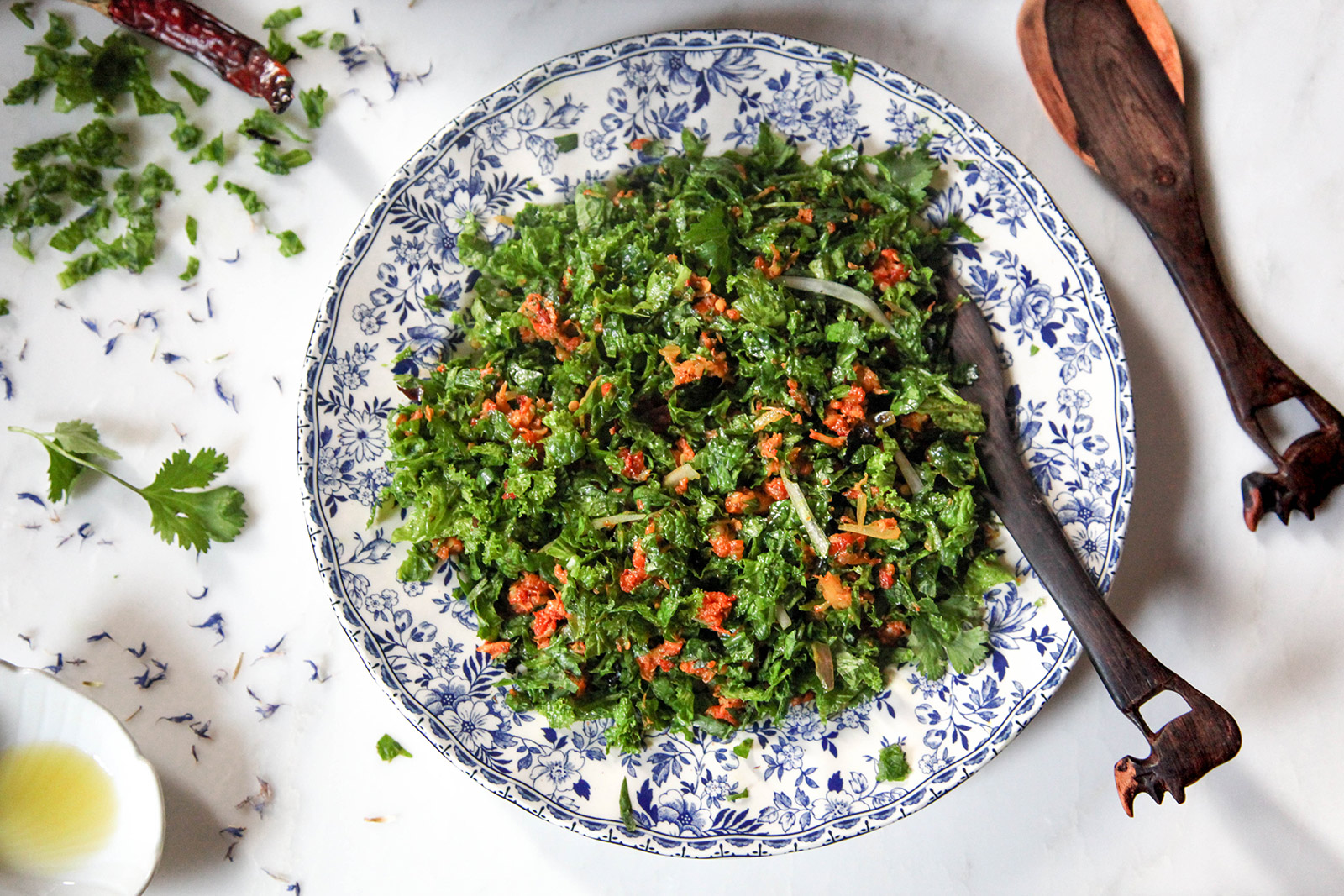
It’s March. Almost spring! I can’t wait for all the greens that’ll be popping up soon in the farmers market. In the meantime, I’ve been eating a salad-style dish that my family used to eat in the winters in Bangladesh, called lai shak bhorta. Winters there are like spring in NYC – basically the best, loveliest time of the year. All kinds of vegetables and greens become available at that time of the year. The base for this unique delicious “salad” is mustard greens. And if you’re looking for new salad ideas, this is an utterly delicious one!
If you have’t had mustard greens, it’s similar in texture to kale, but not as tough. The leaves are comparatively tender, they are peppery in taste and have a mustard-like zing. They are very low calorie, high fiber, and highly nutritious – loaded with anti-oxidants, minerals (calcium, iron, magnesium, potassium, zinc, selenium, manganese), vitamins K and C, and also B vitamins. The lai shak raw and chopped (like kale) is fantastically yummy with cooked smashed shrimp. Think of an avocado smash, except it’s shrimp smash. With healthy greens that have a natural bite. I really can’t have enough of this dish, that we call lai shak bhorta.
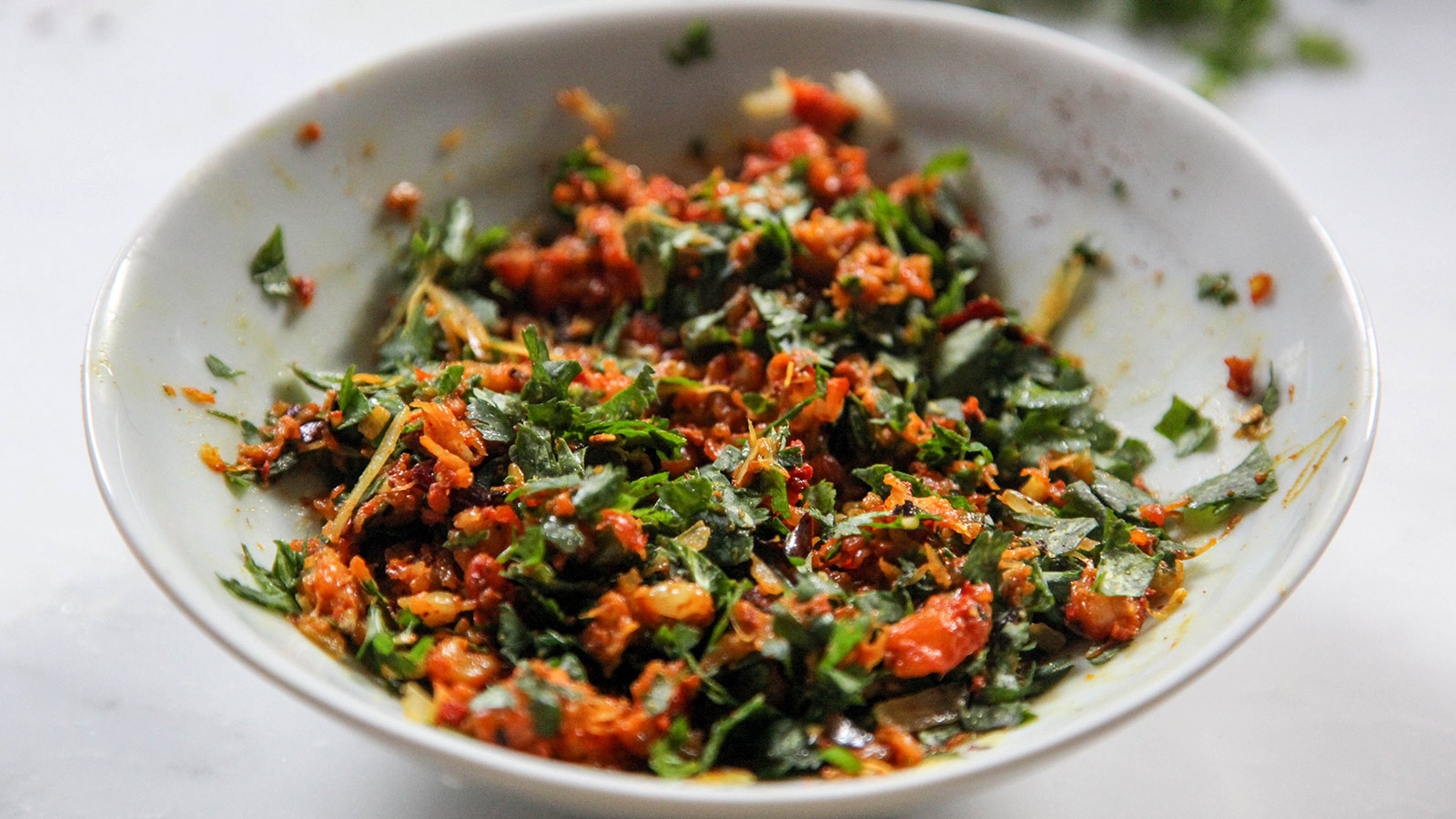
For Bangladeshis who might not have experienced this dish, it’s not traditional Bangladeshi “bhorta” because a bhorta is basically a mash (for example, mashed potatoes are called “alu bhorta” i.e. potato bhorta). The lai shak leaves are not mashed, so therefore it shouldn’t really be called a bhorta, even though that’s what I remember it being called. The leaves are chopped fine, and eaten raw, so it’s like a chopped salad that you would get nowadays at salad places like Chopt in NY.
While the lai shak bhorta isn’t really a bhorta, it’s neither a dish that’s eaten in the rest of Bangladesh, as far as I know. It’s from Sylhet, the north-east region of Bangladesh, that borders the areas of Assam, Meghalaya, Manipur in India. Sylhet looks physically quite different from the rest of Bangladesh – with hills, tea gardens, orange and pineapple groves, wetlands that suddenly turn into massive lake-like areas (called “haors”)in the monsoon season, areas filled wth migratory birds in the winter… It has its own linguistic dialect that most Bengalis have a hard time understanding.
A lot of Sylheti food too is very different from the rest of Bangladeshi food. From traveling around south-east Asia, I’ve come to realize that Sylheti food has a lot in common with south-east asian cuisine – such as sticky rice, bamboo shoots, flavored sticky rice inserted into bamboo sticks and buried under coals that infuses it with amazing aroma, dried citrusy fruits incorporated in curries, tangy sour soupy curries cooked with fish and dried or fresh fruits or seasonal leafy vegetables, etc. Most of these dishes are not eaten in Dhaka, the capital city I grew up in. However, my dad’s ancestral home was in Sylhet, and my mom’s parents’ ancestral homes were in two other parts of the country, and she had been born and brought up in Dhaka, so were lucky to eat an eclectic mix of regional food from various parts Bangladesh. Since I now get to eat Sylheti food so rarely, especially in NYC where the handful of Bangladeshi restaurants don’t serve any Sylheti food, I miss it even more so.

After both my parents passed away in NYC, about a year ago my siblings and I made a bittersweet trip to Bangladesh, to our house in Dhaka. Our lovely light-filled house was physically just as my parents had left it, but had turned into a place of sorrow and memories of happier times. We wanted my little nephews who had come from Switzerland to have some fun in Bangladesh, and not just associate their father’s homeland with sadness. So we decided to take a trip to Sylhet to visit my dad’s ancestral home and see the caretakers and their families, visit relatives elsewhere in Sylhet, see some beautiful places and find some joy.


The caretakers and the villagers were so excited to see us all, and we and our nephews had the best time of the whole trip there. The kids made friends with the village kids, played cricket, roamed around the fields. I would wake up at dawn (the roosters crowing would wake me up), have a cup of hot tea, and then take a walk through the village to the freshly harvested fields, all still covered with dense early morning winter fog. In the cool dawn, wrapped in my dad’s shawl, the world felt mysterious and magical. Shapes would suddenly appear out of the thick fog and we could only make out each other’s faces when we were just inches away. They would ask who I was, and would be delighted to find out once I told them I was my dad’s daughter. Everyone had stories about him and my mom, that they’d love to share. My mom had been considered a foreigner since she wasn’t from Sylhet and didn’t speak the Sylheti dialect (which Bangladeshis don’t usually understand), but everyone universally loved her – and this is not an exaggeration. They all loved the beautiful stylish sophisticated woman who was so charming and full of joy and easily made friends with everyone, so down-to-earth that she made friends with and remembered every detail of the poorest of the villagers’ lives, and would love to spend hours with them and go into their humble homes and sit on the floor, laugh with them, hear all their stories, bond with them and eat with them. We were the lucky recipients of the goodwill and love my parents had created all over. (My parents used to take us there for two weeks every winter while I had been growing up, so I myself have very fun and fond childhood memories of Sylhet.)


While we were wandering around the Sylhet region, my dad’s aunt invited us to her place for dinner. She invited a bunch of other relatives over too so we had a wonderful evening at her place. And she cooked us a feast, of 13 dishes, plus dessert! She knew how much I loved Sylheti food, so she made the simple hard-to-find homestyle dishes, one of which was the lai shak bhorta I loved from my childhood. I asked her how she made it, and when we went back to Dhaka, I requested our cook to make it. They searched almost every market in Dhaka city, but they were unable to locate any lai shak unfortunately. And I remembered that in the winters, my dad would have lai shak and other seasonal food items especially hand carried to Dhaka – all the way from Sylhet.
When I returned to NYC, I googled lai shak, and it turns out Assamese people also eat it, they call it laai xaak. And the english name for it is mustard greens. I had never eaten mustard greens in this country and I told a friend of mine the story, wondering how to locate mustard greens. My cute fashionista caucasian friend from Brooklyn who had grown up in North Carolina, looked and me and broke out in laughter. Apparently mustard greens are very common in the south, and she had grown up eating this mysterious vegetable that had been so hard to locate in Dhaka city. And it’s easily available in NYC too!

Anyway, so now I can make lai shak whenever I crave it. Traditionally, in Sylhet, they mix with a bhorta/smash made from snakehead fish (called taki mach in Bangla). But since that’s not easy to find here, I use shrimp instead, and it turns out delicious! Traditionally the lai shak bhorta is eaten with plain boiled rice, and I recommend you do so too – since the sharp bite from the mustard greens is tempered nicely by the rice.
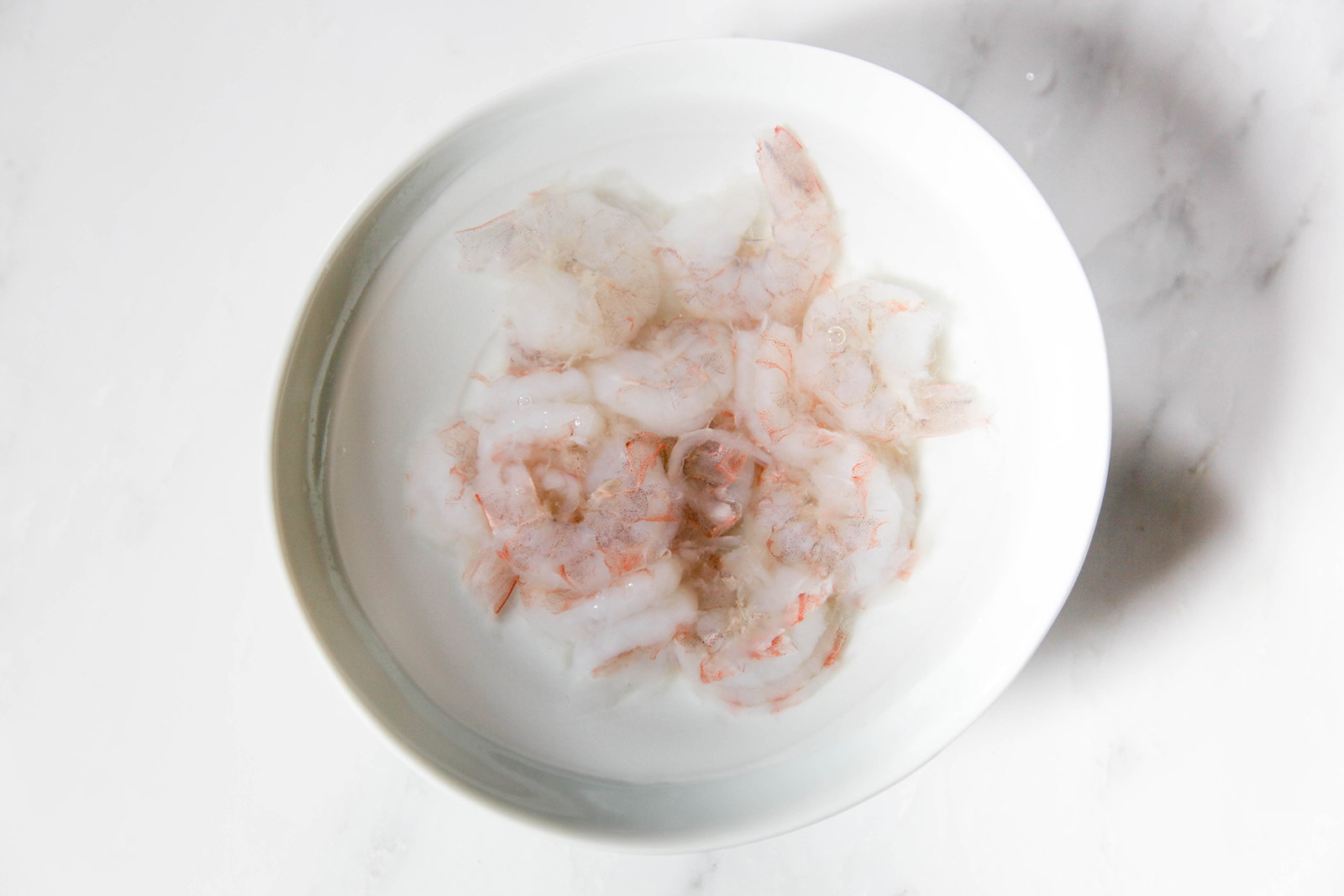


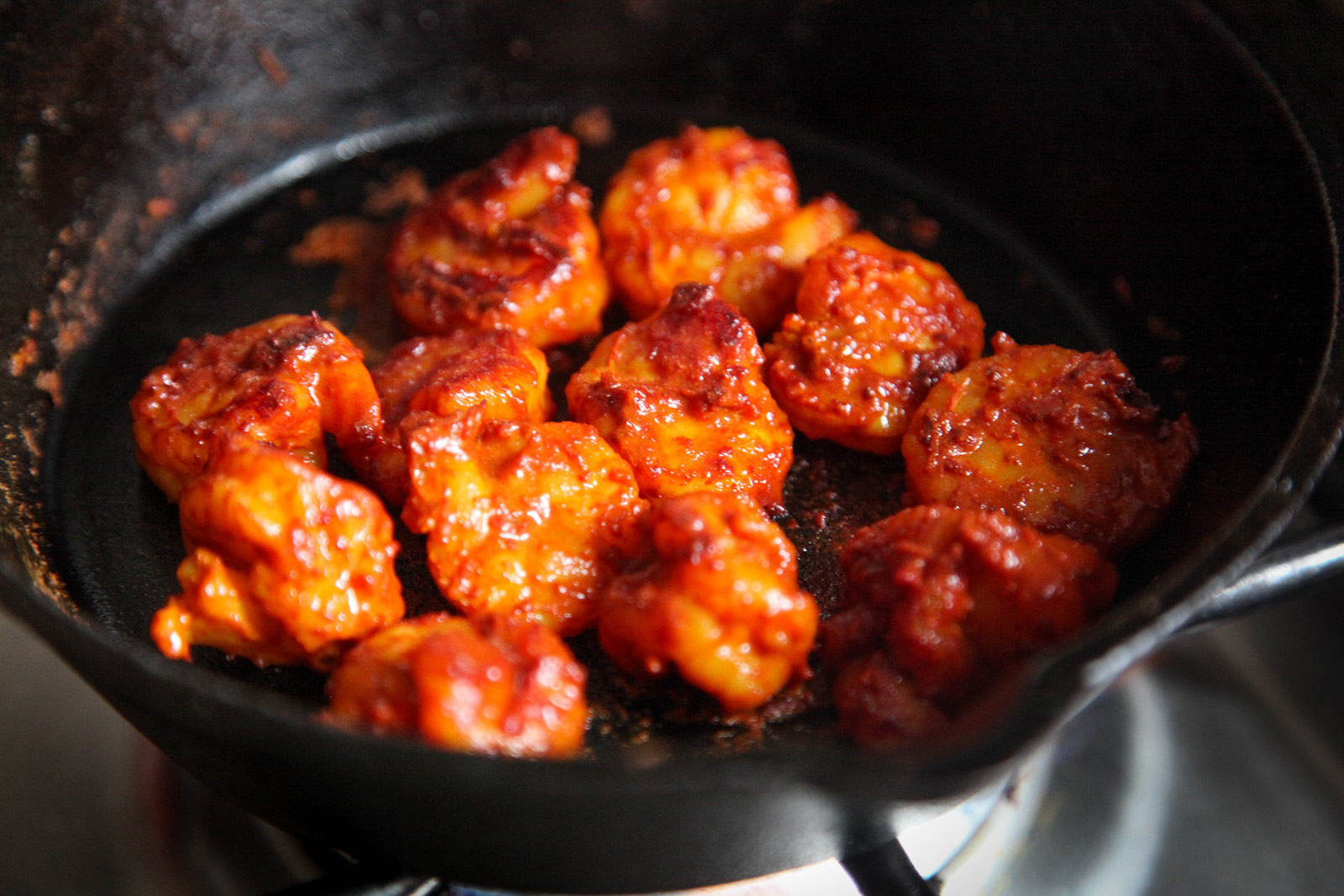



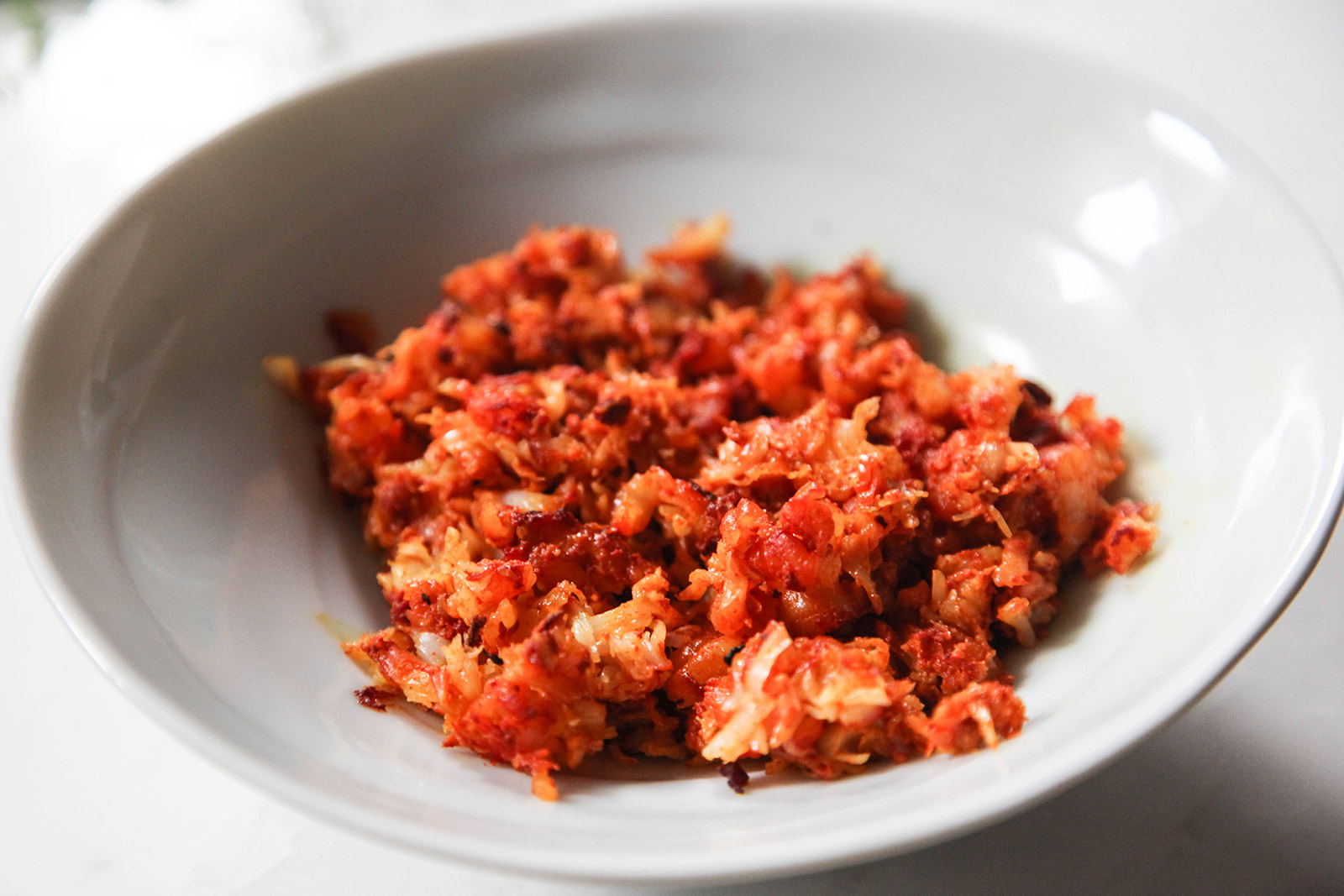



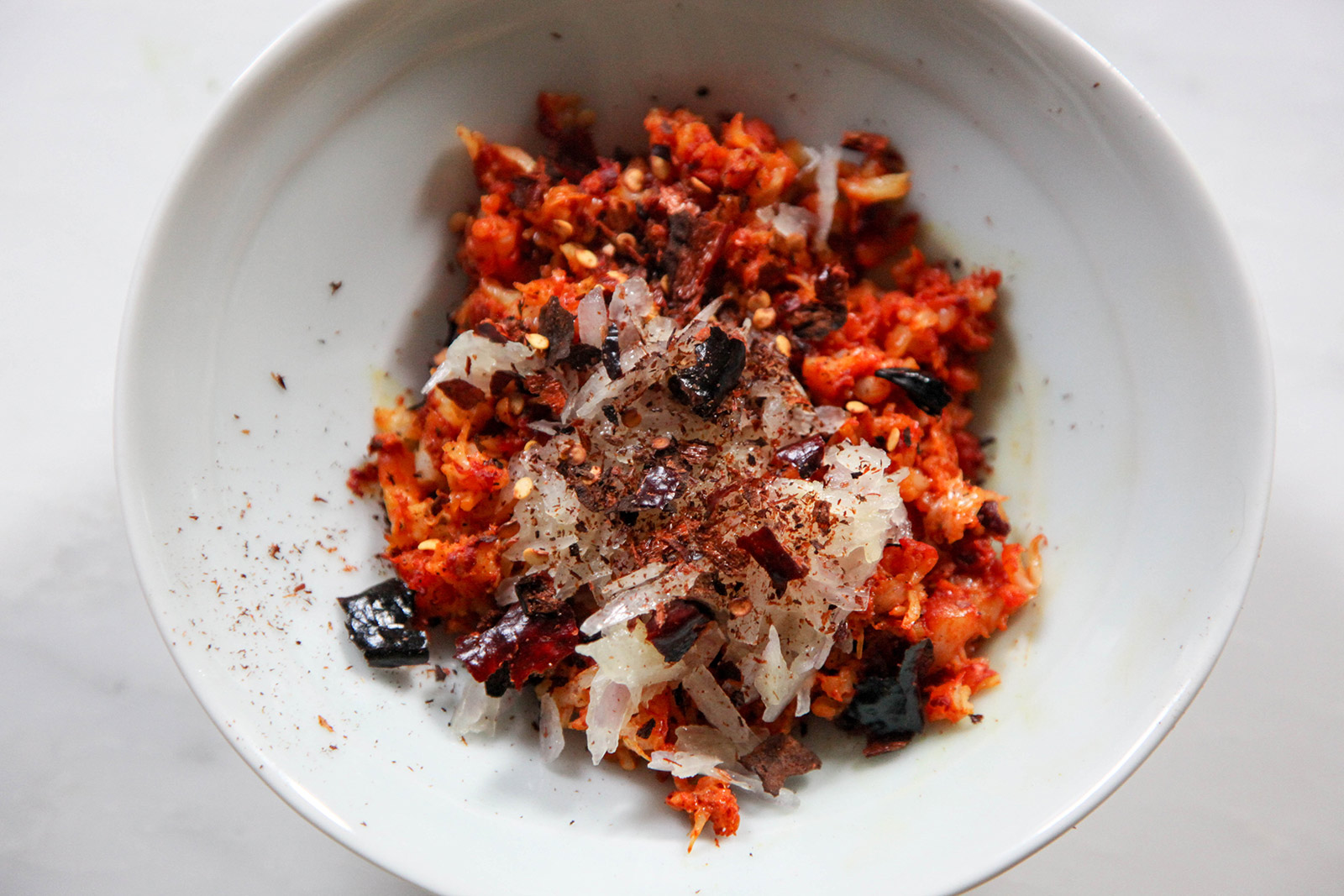
Sylheti Lai Shak – Mustard Greens Salad with Shrimp Smash
SERVES: 2
INGREDIENTS
- 1 and 1/2 cup mustard green leaves, removed from stem
- 12-14 shrimp, shelled
- 1 teaspoon turmeric powder
- 1 small shallot (about 2 tablespoons), thinly sliced
- 1/2-2 dried whole red chilies (use 1/2 if you want it mildly spicy; if you want it super spicy, use 2)
- 1 tablespoon olive oil
- 1/4 cup cilantro leaves, de-stemmed, and chopped
- 1/2 teaspoon salt (or to taste)
METHOD
- Shell the shrimp and soak in a bowl of water for about 5 mintes. Drain water and thoroughly rinse shrimp under cold water. (You can skip this step if you want; I do it because most store-bought shrimp is pre-frozen and this helps get rid of the fishy/shrimpy smell).
- Marinate shrimp with turmeric powder and 1/4 teaspoon of the salt, and leave for 2-3 minutes.
- Heat a small skillet over medium hight heat till it’s hot (if it’s a heavy bottomed skillet, like cast iron, heat for about a minute; for thinner metal you’ll need to heat for less time). Add the dried whole red chillies and toast for about 3 minutes, turning over a few times until lightly charred. Remove chilies from the pan and let cool. This will add a light smoky flavor to the salad mash.
- Add 3/4 tablespoon oil to the skillet. Add marinated shrimp and fry for about 3-4 minutes, stirring regularly. Remove shrimp from pan and set aside to cool.
- Wash the mustard green leaves throughly under cold water. Shake excess water off, and tear the leaves from the stems.
- Bunch the leaves, slice and chop finely.
- Smash the cooled shrimp (can use a masher or fork).
- Similarly, roughly smash the shallot slices. Don’t use a food processor, because you don’t want to turn it into a mushy liquid. Lightly smashing the shallots releases the flavor and mixes well with the smash salad a whole.
- Add the smashed shallots to the smashed shrimp, crumble the charred dried pepper on top and mix well. I use only 1/2 of one of the charred peppers at this point, and add more of what I prepared to the final salad mix if I feel like it needs a little bit more spice. To get the smoky flavor without the heat, break the pepper in half and shake out and throw away the seeds; crumble the pepper shell into the shrimp and shallot mix.
- Add chopped cilantro to the mix.
- Now add this mix to the chopped mustard leaves, add remaining 1/4 tablespoon oil, and 1/4 teaspoon salt. Taste and check for level of spiciness, if you want it more spicy hot, crumble in more of the charred pepper and mix in.
Serve with plain boiled rice. For a Bangladeshi style meal, you can include dal and a curry to serve along with the bhorta.


